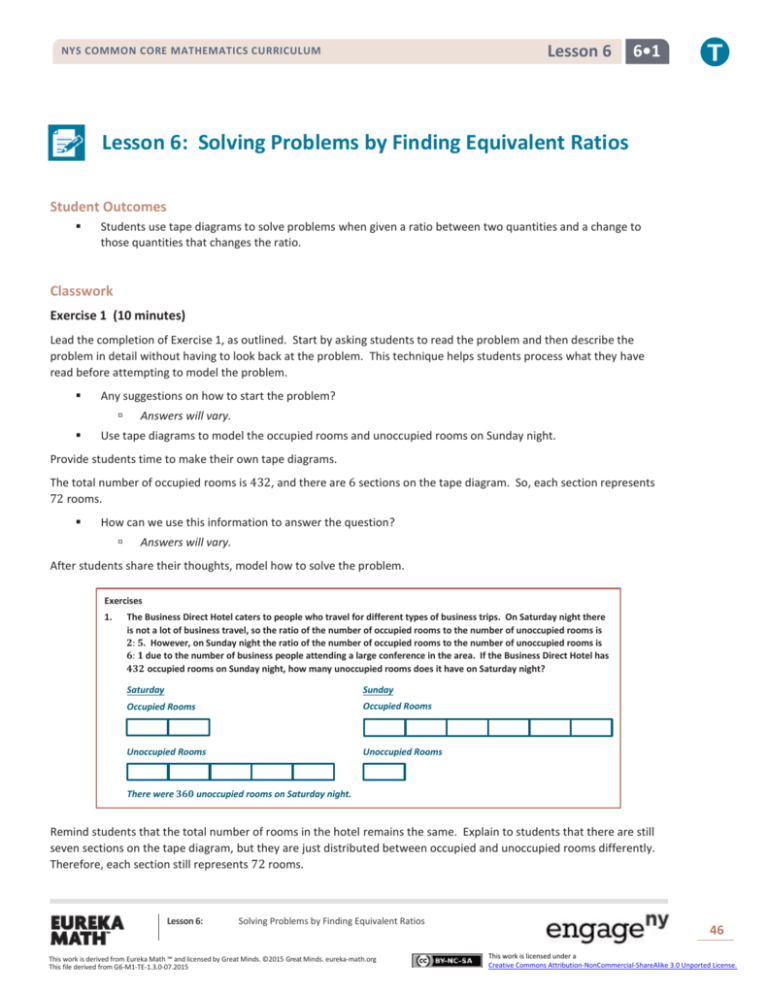Lesson 6: Solving Problems by Finding Equivalent Ratios
advertisement

Lesson 6 NYS COMMON CORE MATHEMATICS CURRICULUM 6•1 Lesson 6: Solving Problems by Finding Equivalent Ratios Student Outcomes Students use tape diagrams to solve problems when given a ratio between two quantities and a change to those quantities that changes the ratio. Classwork Exercise 1 (10 minutes) Lead the completion of Exercise 1, as outlined. Start by asking students to read the problem and then describe the problem in detail without having to look back at the problem. This technique helps students process what they have read before attempting to model the problem. Any suggestions on how to start the problem? Answers will vary. Use tape diagrams to model the occupied rooms and unoccupied rooms on Sunday night. Provide students time to make their own tape diagrams. The total number of occupied rooms is 432, and there are 6 sections on the tape diagram. So, each section represents 72 rooms. How can we use this information to answer the question? Answers will vary. After students share their thoughts, model how to solve the problem. Exercises 1. The Business Direct Hotel caters to people who travel for different types of business trips. On Saturday night there is not a lot of business travel, so the ratio of the number of occupied rooms to the number of unoccupied rooms is 𝟐: 𝟓. However, on Sunday night the ratio of the number of occupied rooms to the number of unoccupied rooms is 𝟔: 𝟏 due to the number of business people attending a large conference in the area. If the Business Direct Hotel has 𝟒𝟑𝟐 occupied rooms on Sunday night, how many unoccupied rooms does it have on Saturday night? Saturday Sunday Occupied Rooms Occupied Rooms Unoccupied Rooms Unoccupied Rooms There were 𝟑𝟔𝟎 unoccupied rooms on Saturday night. Remind students that the total number of rooms in the hotel remains the same. Explain to students that there are still seven sections on the tape diagram, but they are just distributed between occupied and unoccupied rooms differently. Therefore, each section still represents 72 rooms. Lesson 6: Solving Problems by Finding Equivalent Ratios This work is derived from Eureka Math ™ and licensed by Great Minds. ©2015 Great Minds. eureka-math.org This file derived from G6-M1-TE-1.3.0-07.2015 46 This work is licensed under a Creative Commons Attribution-NonCommercial-ShareAlike 3.0 Unported License. Lesson 6 NYS COMMON CORE MATHEMATICS CURRICULUM 6•1 Exercises 2–7 (25 minutes) Have students work in small groups to solve each problem. Assign each group a problem to share with the class. Leave about 710 minutes to allow groups to present to the class. 2. Peter is trying to work out by completing sit-ups and push-ups in order to gain muscle mass. Originally, Peter was completing five sit-ups for every three push-ups, but then he injured his shoulder. After the injury, Peter completed the same number of repetitions as he did before his injury, but he completed seven sit-ups for every one push-up. During a training session after his injury, Peter completed eight push-ups. How many push-ups was Peter completing before his injury? Peter was completing 𝟐𝟒 push-ups before his injury. 3. Tom and Rob are brothers who like to make bets about the outcomes of different contests between them. Before the last bet, the ratio of the amount of Tom’s money to the amount of Rob’s money was 𝟒: 𝟕. Rob lost the latest competition, and now the ratio of the amount of Tom’s money to the amount of Rob’s money is 𝟖: 𝟑. If Rob had $𝟐𝟖𝟎 before the last competition, how much does Rob have now that he lost the bet? Rob has $𝟏𝟐𝟎. 4. A sporting goods store ordered new bikes and scooters. For every 𝟑 bikes ordered, 𝟒 scooters were ordered. However, bikes were way more popular than scooters, so the store changed its next order. The new ratio of the number of bikes ordered to the number of scooters ordered was 𝟓: 𝟐. If the same amount of sporting equipment was ordered in both orders and 𝟔𝟒 scooters were ordered originally, how many bikes were ordered as part of the new order? 𝟖𝟎 bikes were ordered as part of the new order. 5. At the beginning of Grade 6, the ratio of the number of advanced math students to the number of regular math students was 𝟑: 𝟖. However, after taking placement tests, students were moved around changing the ratio of the number of advanced math students to the number of regular math students to 𝟒: 𝟕. How many students started in regular math and advanced math if there were 𝟗𝟐 students in advanced math after the placement tests? There were 𝟔𝟗 students in advanced math and 𝟏𝟖𝟒 students in regular math before the placement tests. 6. During first semester, the ratio of the number of students in art class to the number of students in gym class was 𝟐: 𝟕. However, the art classes were really small, and the gym classes were large, so the principal changed students’ classes for second semester. In second semester, the ratio of the number of students in art class to the number of students in gym class was 𝟓: 𝟒. If 𝟕𝟓 students were in art class second semester, how many were in art class and gym class first semester? There were 𝟑𝟎 students in art class and 𝟏𝟎𝟓 students in gym class during first semester. 7. Jeanette wants to save money, but she has not been good at it in the past. The ratio of the amount of money in Jeanette’s savings account to the amount of money in her checking account was 𝟏: 𝟔. Because Jeanette is trying to get better at saving money, she moves some money out of her checking account and into her savings account. Now, the ratio of the amount of money in her savings account to the amount of money in her checking account is 𝟒: 𝟑. If Jeanette had $𝟗𝟑𝟔 in her checking account before moving money, how much money does Jeanette have in each account after moving money? Jeanette has $𝟔𝟐𝟒 in her savings account and $𝟒𝟔𝟖 in her checking account after moving money. Lesson 6: Solving Problems by Finding Equivalent Ratios This work is derived from Eureka Math ™ and licensed by Great Minds. ©2015 Great Minds. eureka-math.org This file derived from G6-M1-TE-1.3.0-07.2015 47 This work is licensed under a Creative Commons Attribution-NonCommercial-ShareAlike 3.0 Unported License. NYS COMMON CORE MATHEMATICS CURRICULUM Lesson 6 6•1 Closing (5 minutes) What advice would you have for a friend who missed class today and needed to do the Problem Set? If a problem has a ratio that changes, it is best to do one tape diagram for the before and another for the after so you can visualize the change. Lesson Summary When solving problems in which a ratio between two quantities changes, it is helpful to draw a before tape diagram and an after tape diagram. Exit Ticket (5 minutes) Lesson 6: Solving Problems by Finding Equivalent Ratios This work is derived from Eureka Math ™ and licensed by Great Minds. ©2015 Great Minds. eureka-math.org This file derived from G6-M1-TE-1.3.0-07.2015 48 This work is licensed under a Creative Commons Attribution-NonCommercial-ShareAlike 3.0 Unported License. Lesson 6 NYS COMMON CORE MATHEMATICS CURRICULUM Name 6•1 Date Lesson 6: Solving Problems by Finding Equivalent Ratios Exit Ticket Students surveyed boys and girls separately to determine which sport was enjoyed the most. After completing the boy survey, it was determined that for every 3 boys who enjoyed soccer, 5 boys enjoyed basketball. The girl survey had a ratio of the number of girls who enjoyed soccer to the number of girls who enjoyed basketball of 7: 1. If the same number of boys and girls were surveyed, and 90 boys enjoy soccer, how many girls enjoy each sport? Lesson 6: Solving Problems by Finding Equivalent Ratios This work is derived from Eureka Math ™ and licensed by Great Minds. ©2015 Great Minds. eureka-math.org This file derived from G6-M1-TE-1.3.0-07.2015 49 This work is licensed under a Creative Commons Attribution-NonCommercial-ShareAlike 3.0 Unported License. NYS COMMON CORE MATHEMATICS CURRICULUM Lesson 6 6•1 Exit Ticket Sample Solutions Students surveyed boys and girls separately to determine which sport was enjoyed the most. After completing the boy survey, it was determined that for every 𝟑 boys who enjoyed soccer, 𝟓 boys enjoyed basketball. The girl survey had a ratio of the number of girls who enjoyed soccer to the number of girls who enjoyed basketball of 𝟕: 𝟏. If the same number of boys and girls were surveyed, and 𝟗𝟎 boys enjoy soccer, how many girls enjoy each sport? The girl survey would show that 𝟐𝟏𝟎 girls enjoy soccer, and 𝟑𝟎 girls enjoy basketball. Problem Set Sample Solutions 1. Shelley compared the number of oak trees to the number of maple trees as part of a study about hardwood trees in a woodlot. She counted 𝟗 maple trees to every 𝟓 oak trees. Later in the year there was a bug problem, and many trees died. New trees were planted to make sure there were the same number of trees as before the bug problem. The new ratio of the number of maple trees to the number of oak trees is 𝟑: 𝟏𝟏. After planting new trees, there were 𝟏𝟑𝟐 oak trees. How many more maple trees were in the woodlot before the bug problem than after the bug problem? Explain. There were 𝟕𝟐 more maple trees before the bug problem than after because there were 𝟏𝟎𝟖 maples trees before the bug problem and 𝟑𝟔 maple trees after the bug problem. 2. The school band is comprised of middle school students and high school students, but it always has the same maximum capacity. Last year the ratio of the number of middle school students to the number of high school students was 𝟏: 𝟖. However, this year the ratio of the number of middle school students to the number of high school students changed to 𝟐: 𝟕. If there are 𝟏𝟖 middle school students in the band this year, how many fewer high school students are in the band this year compared to last year? Explain. There are 𝟗 fewer high school students in the band this year when compared to last year because last year there were 𝟕𝟐 high school students in the band, and this year there are only 𝟔𝟑 high school students in the band. Lesson 6: Solving Problems by Finding Equivalent Ratios This work is derived from Eureka Math ™ and licensed by Great Minds. ©2015 Great Minds. eureka-math.org This file derived from G6-M1-TE-1.3.0-07.2015 50 This work is licensed under a Creative Commons Attribution-NonCommercial-ShareAlike 3.0 Unported License.








